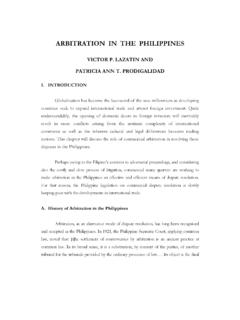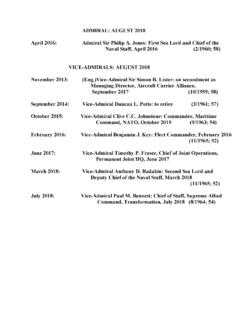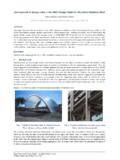Transcription of The Political Psychology of Terrorist Alarms Philip G ...
1 The Political Psychology of Terrorist Alarms Philip G. Zimbardo, Ph. D. (3 01 03) On April 18, 1775, patriot Paul Revere rode his horse on the famous midnight ride from Boston harbor toward Lexington, warning local colonial leaders along the way that the British army, the Redcoats, were coming. He urged them to take up arms to oppose their tyrannical rule. When the British arrived the next day, they were defeated at Concord by the colonial militia, and America s Revolutionary War had its auspicious beginning. Revere s warning was effective for four reasons: 1) he was known to be a highly credible communicator, both expert and trustworthy; 2) his alarm was focused on a specific anticipated event; 3) it was designed to motivate citizens to act, and 4) it called for a concrete set of actions.
2 This Paul Revere paradigm for successful dissemination of public Alarms is supported by contemporary psychological research. To be optimally effective, such Alarms should arouse only a moderate level of motivation -- too low doesn t energize action, and too high creates emotional overload and competing, distracting behaviors. The Alarms must be based on reliable evidence, and presented clearly by trustworthy sources about specific dangers or threats that may be dealt with by taking some recommended action. If the threat is likely to persist over an extended time period, debriefing after an alarm is essential to correct misinformation, modify faulty recommendations, and to reinforce citizens for heeding the message and to reassure them of the value of their collaborative efforts.
3 Finally, if the threat does not materialize, a reputable authority must provide some explanation of why, and then also lower or remove the threat alert. Violations of Effective Alarm Principles All of these basic, rather obvious, principles have been systematically violated in the design and delivery of the first six Terrorist Alarms issued by government officials to warn the public of imminent Terrorist dangers. Different communicators were alleged to have reliable information from credible sources about an imminent attack by terrorists somewhere, some time soon, in the United States, or anywhere in the world against its offices or agencies. These Alarms worked to create high levels of citizen fear, which over time morphed into generalized anxiety.
4 There was no concrete action that citizens might take, other than to remain on alert and to keep their eyes open. The initial message, whether emanating from the Attorney General or other authorities, got replayed endlessly by different media sources and elaborated by various expert commentators. The psychological situation worsened when cognitive-emotional dissonance was induced by the administration s collateral message to go about your business as normal. How is that possible after having declared the nation is under potential Terrorist threat and our personal safety and security is about to be violated once again as it was on 9/11? The resulting sense of confusion spills over into feelings of helplessness and results in less than optimal information processing that would be essential to cope with Terrorist attacks.
5 It was never clear why the government had to warn the general public and not just relevant security forces at local and national levels since given that there was nothing 1meaningful we could do other than to become open-eyed worriers. But then there were none! Not a single Terrorist attack on American soil for the past 17 months since September 11th. Where are the alleged thousands of terrorists inhabiting cells in our country? And where was the debriefing by our authorities to explain why nothing happened? It was nowhere in sight or sound. The high alert and its high anxiety induction just silently evaporated until another month or two, when the next call to alarm was sounded again, and again. We know from the classic story of the Boy Who Cried Wolf that after only three false Alarms , people cease to take seriously the validity of previously credible messengers.
6 After six no-consequence Alarms , many Americans became desensitized to the need to be on high alert -- yet still lead normal lives. But for some, it became normal to be anxiously dreading the worst, given the lesson of the first horrific attacks on the World Trade Center and Pentagon. That prolonged state of worry about one s vulnerability without any clear action to alter it, can have a profoundly negative impact on our individual and collective mental health. I call it a pre-traumatic stress syndrome. It is likely that the failure even to debrief the nation after these false Alarms was based on an inadequate public warning model that did not take into sufficient account their psychological impact. It may be that government officials felt no need for corrective information because they had already reminded the public not to worry and lead normal lives.
7 Better safe than sorry, better we warned you and nothing happened than we did not, and something happened -- was the apparent reasoning. Or maybe, they realized they were wrong in their estimates and did not want to go public with that admission. Or, a more provocative hypothesis is that maybe they just preferred that the public remain eternally vigilant despite the psychic toll. And Then There Were Seven Something unusual must have happened between the last of the unmarked six-pack of Terrorist warnings and the recent brightly Orange-colored, newly-framed Seventh Alarm that seemed at first to fit the psychologically effective Revere paradigm. It was presented clearly by one communicator, Tom Ridge, Head of Homeland Security, and it amplified the reliability of his source by indicating it was detected from multiple intelligence sources.
8 It identified the Terrorist targets as soft -- American homes and hotels which targets everybody. In the next days, the target list expanded to include airlines, symbolic and strategic venues. The anticipated Terrorist weapons escalated to the unthinkable; weapons of mass destruction -- chemical, biological, and radiological dirty bombs. With that much detail on the input side, then the Homeland Security Head added a shopping list of concrete actions Americans should take on the output side to be prepared for this all-out attack from any of the reported thousand terrorists operating on American soil and preparing to use these weapons of mass destruction against innocent civilians. Experts warned us over and over, on CNN, MSNBC, Fox, and other networks, to gas up our cars in case of immediate evacuation (and then the east coast was snowbound for days), store emergency supplies (as when preparing for natural disasters), and seal ourselves in our homes using plastic sheeting and duct tape.
9 At last, we had a set of concrete actions we could take which seemed better than just sitting idly waiting for the inevitable. To make sure this message got on the nation s psyche radar, after the mind- 2dulling previous six false Alarms , the Orange Alert was sounded and local, state and federal forces swung into defensive actions. Near panic buying of the recommended supplies followed in many cities. Amazingly, the collateral second message was once again sounded -- about living our lives as usual, going about our business as normal, when anticipating that a panoply of weapons of mass destruction were about to implode our homes! But then it all began to unravel, as experts said we could suffocate by sealing off ventilation into our homes, and others said some of the reliable sources were hoaxes.
10 Nevertheless, the Orange Alert remained in effect for weeks while the Head of Homeland Security began a nationwide campaign to promote emergency preparedness, fashioned after the programs of FEMA for natural disaster readiness, and supported by focus-group recommendations (obviously not the same focus groups dismissed by the President in his disdain of world-wide, massive anti-war protests). However, it should be apparent that natural disasters and disasters caused by human agents require very different models of response, since God and the impartial laws of nature are generally credited with nature gone awry, while the Devil s evil doing is behind human nature s malevolence. The Psychology of Terrorism Terrorism is not about war in any traditional sense of destroying the material resources of an enemy nation and taking over their country.






